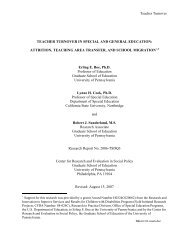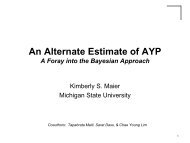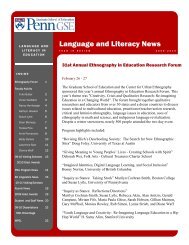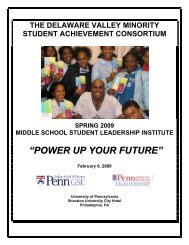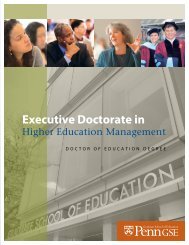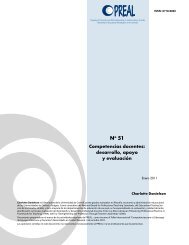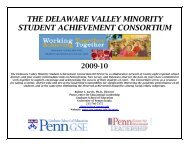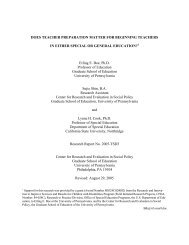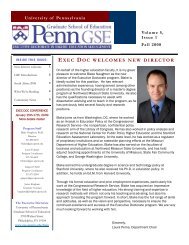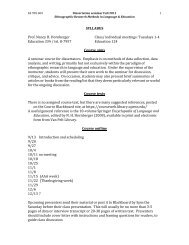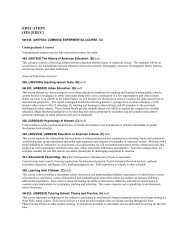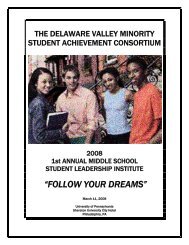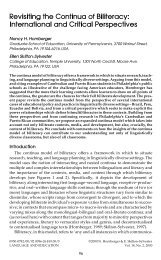Multilingual language policy and school linguistic practice
Multilingual language policy and school linguistic practice
Multilingual language policy and school linguistic practice
You also want an ePaper? Increase the reach of your titles
YUMPU automatically turns print PDFs into web optimized ePapers that Google loves.
This article was downloaded by: [University of Pennsylvania]<br />
On: 24 February 2009<br />
Access details: Access Details: [subscription number 906604682]<br />
Publisher Routledge<br />
Informa Ltd Registered in Engl<strong>and</strong> <strong>and</strong> Wales Registered Number: 1072954 Registered office: Mortimer House,<br />
37-41 Mortimer Street, London W1T 3JH, UK<br />
Compare: A Journal of Comparative <strong>and</strong> International Education<br />
Publication details, including instructions for authors <strong>and</strong> subscription information:<br />
http://www.informaworld.com/smpp/title~content=t713410984<br />
<strong>Multilingual</strong> <strong>language</strong> <strong>policy</strong> <strong>and</strong> <strong>school</strong> <strong>linguistic</strong> <strong>practice</strong>: globalization <strong>and</strong><br />
English-<strong>language</strong> teaching in India, Singapore <strong>and</strong> South Africa<br />
Nancy Hornberger a ; Viniti Vaish b<br />
a<br />
Graduate School of Education, University of Pennsylvania, Philadelphia, PA, USA b Centre for Research in<br />
Pedagogy <strong>and</strong> Practice, National Institute, Singapore<br />
First Published on: 10 November 2008<br />
To cite this Article Hornberger, Nancy <strong>and</strong> Vaish, Viniti(2008)'<strong>Multilingual</strong> <strong>language</strong> <strong>policy</strong> <strong>and</strong> <strong>school</strong> <strong>linguistic</strong> <strong>practice</strong>: globalization<br />
<strong>and</strong> English-<strong>language</strong> teaching in India, Singapore <strong>and</strong> South Africa',Compare: A Journal of Comparative <strong>and</strong> International Education,<br />
To link to this Article: DOI: 10.1080/03057920802469663<br />
URL: http://dx.doi.org/10.1080/03057920802469663<br />
PLEASE SCROLL DOWN FOR ARTICLE<br />
Full terms <strong>and</strong> conditions of use: http://www.informaworld.com/terms-<strong>and</strong>-conditions-of-access.pdf<br />
This article may be used for research, teaching <strong>and</strong> private study purposes. Any substantial or<br />
systematic reproduction, re-distribution, re-selling, loan or sub-licensing, systematic supply or<br />
distribution in any form to anyone is expressly forbidden.<br />
The publisher does not give any warranty express or implied or make any representation that the contents<br />
will be complete or accurate or up to date. The accuracy of any instructions, formulae <strong>and</strong> drug doses<br />
should be independently verified with primary sources. The publisher shall not be liable for any loss,<br />
actions, claims, proceedings, dem<strong>and</strong> or costs or damages whatsoever or howsoever caused arising directly<br />
or indirectly in connection with or arising out of the use of this material.
Compare<br />
2008, iFirst Article, 1–15<br />
<strong>Multilingual</strong> <strong>language</strong> <strong>policy</strong> <strong>and</strong> <strong>school</strong> <strong>linguistic</strong> <strong>practice</strong>: globalization <strong>and</strong><br />
English-<strong>language</strong> teaching in India, Singapore <strong>and</strong> South Africa<br />
Nancy Hornberger a * <strong>and</strong> Viniti Vaish b<br />
a Graduate School of Education, University of Pennsylvania, Philadelphia, PA, USA; b Centre for<br />
Research in Pedagogy <strong>and</strong> Practice, National Institute, Singapore<br />
Downloaded By: [University of Pennsylvania] At: 21:26 24 February 2009<br />
This paper explores tensions in translating multilingual <strong>language</strong> <strong>policy</strong> to classroom<br />
<strong>linguistic</strong> <strong>practice</strong>, <strong>and</strong> especially the paradoxical role of <strong>and</strong> dem<strong>and</strong> for English as a<br />
tool of decolonization for multilingual populations seeking equitable access to a<br />
globalizing economy. We take an ecological <strong>and</strong> socio<strong>linguistic</strong> approach, depicting<br />
tensions between multilingualism <strong>and</strong> English across three national cases, at both <strong>policy</strong><br />
<strong>and</strong> classroom level. Despite India’s egalitarian Three Language Formula (TLF) of<br />
1968, many Indian children are being educated in a <strong>language</strong> which is not their mother<br />
tongue. Singapore’s bilingual education <strong>policy</strong> with English medium of instruction <strong>and</strong><br />
mother tongues taught as second <strong>language</strong>s nevertheless leaves the <strong>linguistic</strong> capital of<br />
multilingual children who speak a pidginized variety of English called ‘Singlish’ out of<br />
the equation, since the <strong>school</strong> medium is st<strong>and</strong>ard English. South Africa’s Constitution<br />
of 1993 embraces multilingualism as a national resource, raising nine major African<br />
<strong>language</strong>s to national official status alongside English <strong>and</strong> Afrikaans, yet with the<br />
freedom of movement accompanying the dismantling of apartheid, large numbers of<br />
African <strong>language</strong>-speaking parents seek to place their children in English-medium<br />
instructional contexts. Given the push for English <strong>and</strong> simultaneous official valuing of<br />
multilingualism in all three cases, we briefly consider illustrative classroom examples<br />
<strong>and</strong> argue that multilingual classroom <strong>practice</strong>s can be a resource through which<br />
children access St<strong>and</strong>ard English while also cultivating their own local <strong>language</strong>s.<br />
Keywords: globalization; <strong>language</strong> in education <strong>policy</strong>; medium of instruction; continua<br />
of biliteracy<br />
Introduction: globalization <strong>and</strong> English-<strong>language</strong> teaching<br />
One of the consequences of globalization processes is the spread of English as a medium of<br />
instruction in national <strong>school</strong> systems. Disadvantaged communities are increasingly<br />
dem<strong>and</strong>ing access to English so that their children can join a workforce that m<strong>and</strong>ates<br />
knowledge of this <strong>language</strong>. In this paper, we focus on access to the <strong>linguistic</strong> capital of<br />
English <strong>and</strong> how multilingual classroom <strong>practice</strong> tries to meet the dem<strong>and</strong>s of the<br />
community for that access. We look at three cases, Singapore, India <strong>and</strong> South Africa,<br />
where English is a sought-after medium of instruction, while in none of the countries is it<br />
the most frequently spoken <strong>language</strong> of the home.<br />
Sociologists like Ritzer (1993) see globalization as the McDonaldization or the<br />
homogenization worldwide of, particularly, American culture. Phillipson (1992), the<br />
sociolinguist, extends Ritzer’s term ‘McDonaldization’ to the spread of global English<br />
which he thinks of as <strong>linguistic</strong> imperialism that culturally impoverishes the third world by<br />
*Corresponding author. Email: nancyh@gse.upenn.edu<br />
ISSN 0305-7925 print/ISSN 1469-3623 online<br />
# 2008 British Association for International <strong>and</strong> Comparative Education<br />
DOI: 10.1080/03057920802469663<br />
http://www.informaworld.com
2 N. Hornberger <strong>and</strong> V. Vaish<br />
Downloaded By: [University of Pennsylvania] At: 21:26 24 February 2009<br />
eroding its <strong>linguistic</strong> ecology. Phillipson’s view has been critiqued by Fishman (1998–9,<br />
29), who does not see the spread of English as the only <strong>linguistic</strong> effect of globalization. He<br />
comments: ‘For all the … vitriol generated by gr<strong>and</strong>-scale globalization, it is the growth of<br />
regional interactions … that touches the widest array of regional <strong>language</strong>s. These<br />
interactions promote the spread of regional <strong>language</strong>s.’<br />
In this paper we are focused on English as medium of instruction for non-English<br />
speakers <strong>and</strong> not so much on the spread of English creating <strong>language</strong> shift <strong>and</strong> death of<br />
indigenous or regional <strong>language</strong>s. Globalization <strong>and</strong> the changing medium of instruction<br />
is currently a key concern of sociolinguists (Tollefson <strong>and</strong> Tsui 2004; Block <strong>and</strong> Cameron<br />
2002) as it impacts teacher education, curriculum planning, <strong>and</strong> in fact, dem<strong>and</strong>s a<br />
realignment of pedagogy. Despite this concern amongst sociolinguists, cross-national<br />
studies of English classes are rare. An exception is Bhattacharya et al. (2007), which<br />
analyzes grade 9 English classes in Delhi, Johannesburg <strong>and</strong> London with a focus on texts<br />
<strong>and</strong> multimodality. We here look at English as a medium of instruction, at <strong>policy</strong> <strong>and</strong><br />
classroom levels, in each of three countries separately <strong>and</strong> comparatively.<br />
In the case of Singapore, English medium education was supplied by the government<br />
because of overwhelming dem<strong>and</strong> from Singaporeans. Gupta (1997) supports Singapore’s<br />
media of instruction <strong>policy</strong> despite its emphasis on English over mother tongue, saying<br />
that ‘the empowerment of individuals should have primacy over the development of an<br />
individual’s mother tongue, <strong>and</strong> even over the preservation of a <strong>language</strong>’ (Gupta 1997,<br />
497).<br />
Similarly in India, the dem<strong>and</strong> for English is pressurizing the government <strong>school</strong><br />
system to reform the Three Language Formula (TLF). The economist Jean Dreze writes of<br />
government <strong>school</strong>s (called public <strong>school</strong>s in the USA) in India that: ‘in big cities, it’s more<br />
or less over … within 10 to 15 years government <strong>school</strong>s will be almost wiped out’<br />
(International Herald Tribune 2003). Dreze’s pessimism about the government <strong>school</strong><br />
system in India is based partly on the rise of low-cost private <strong>school</strong> education for the poor<br />
(Tooley <strong>and</strong> Dixon 2003). It is our observation that another reason government <strong>school</strong>s in<br />
India are facing attrition is because they offer English only in secondary <strong>school</strong> under the<br />
TLF (see below). However, many of them, like the Rajkiya Sarvodaya Kanya Vidyalaya<br />
(RSKV) we look at here, now offer English medium instruction from the primary <strong>school</strong><br />
itself <strong>and</strong> have thus staunched attrition.<br />
The high status <strong>and</strong> <strong>linguistic</strong> capital of English are equally evident in South Africa, a<br />
case where the hegemony of the Western free-market economy influences a third-world<br />
country’s economy not just in economics but also in the accompanying <strong>linguistic</strong> racism<br />
which gives high status to English (Heugh 1995, 329). Neville Alex<strong>and</strong>er (2002, 92, citing<br />
Alex<strong>and</strong>re 1972, 86) reminds us that comm<strong>and</strong> of the former colonial <strong>language</strong> represents<br />
cultural capital for the black elite, opening the way to recruitment ‘into the ruling class or,<br />
at the very least, to positions of power’, a disturbing scenario wherein a <strong>policy</strong> of de facto<br />
English unilingualism excludes the vast majority <strong>and</strong> ‘ultimately undermines the very<br />
democracy South Africans pride themselves on having attained’ (Alex<strong>and</strong>er 2002, 92).<br />
Along the same lines, Ridge suggests that thorough <strong>and</strong> detailed attention to making<br />
English as widely available as possible, but without undermining the other South African<br />
<strong>language</strong>s, is the best defence against elite closure – ‘the use by an elite of a <strong>language</strong> as a<br />
means of excluding the rest of the population from participation in political <strong>and</strong> economic<br />
life’ (Ridge 2004, 207, citing Myers-Scotton 1990; see also Webb 2004 on the case for using<br />
African <strong>language</strong>s as media of instruction).<br />
All three countries are faced with a highly multilingual <strong>and</strong> ethnically diverse<br />
population <strong>and</strong> all of them have chosen a <strong>language</strong> <strong>policy</strong> based on a different idea of
Compare 3<br />
Downloaded By: [University of Pennsylvania] At: 21:26 24 February 2009<br />
nationalism from Euro-American models. Though in the Euro-American model of nation<br />
state formation, one <strong>language</strong> is considered the dominant national <strong>language</strong>, in the official<br />
policies of India, South Africa <strong>and</strong> Singapore, multiple <strong>language</strong>s are considered equally<br />
representative of the nation. South African <strong>language</strong> <strong>policy</strong> expert <strong>and</strong> advocate<br />
Alex<strong>and</strong>er, taking inspiration from Anderson’s work on imagined communities (1983,<br />
133), puts it thus: ‘community of <strong>language</strong> is not an essential attribute of the nation’ (2002,<br />
86, 88).<br />
These three countries are at different stages in the inexorable processes of globalization<br />
that are affecting all countries. According to the fifth annual Foreign Policy Globalization<br />
Index in 2005, Singapore was the most globalized nation, South Africa ranked 48 <strong>and</strong><br />
India 61 (Kearney 2005). The report makes these rankings on the basis of four main<br />
dimensions: economic integration, personal contact, technological connectivity <strong>and</strong><br />
political engagement. Economic integration includes rankings for trade <strong>and</strong> foreign direct<br />
investment (FDI); personal contact includes phones, travel <strong>and</strong> remittances; technological<br />
connectivity shows rankings for internet users, internet hosts <strong>and</strong> screen servers; <strong>and</strong><br />
political engagement includes international organizations, UN peacekeeping, treaties <strong>and</strong><br />
government transfers. The three countries also differ markedly in measures of per capita<br />
GNP <strong>and</strong> literacy levels (see Table 1).<br />
Finally, in the three countries under discussion, both English <strong>and</strong> mother tongue<strong>language</strong><br />
education carry colonial baggage. In South Africa <strong>and</strong> Singapore, the media of<br />
instruction for all but an elite minority during colonial rule were the mother tongues, a<br />
<strong>policy</strong> that channeled <strong>linguistic</strong> capital inequitably towards the colonizer <strong>and</strong> created<br />
conditions for the excluded majority populations to in turn dem<strong>and</strong> access to the English<br />
<strong>language</strong> as resource. The 1976 Soweto riots in South Africa were exactly about ‘the fight<br />
for the right to <strong>language</strong>’ – access to English versus imposition of Afrikaans (Guma 2006;<br />
see also McLean 1999). In Singapore, Shepherd (2005) <strong>and</strong> Gopinathan (2003) document<br />
that by 1986, enrolment in <strong>school</strong>s offering M<strong>and</strong>arin, Tamil <strong>and</strong> Malay as media of<br />
instruction was so low that the government had to close them down. Consequently, in<br />
1987 English was made the dominant medium of instruction in the national <strong>school</strong> system<br />
to create a level playing field for all <strong>linguistic</strong> groups. This in turn created concern amongst<br />
the Chinese who felt that their <strong>language</strong> <strong>and</strong> culture were being threatened by the global<br />
spread of English. The annual Speak M<strong>and</strong>arin Campaign launched in 1979 <strong>and</strong> the<br />
creation of Special Assistance Plan <strong>school</strong>s in 1980 (where English <strong>and</strong> M<strong>and</strong>arin are<br />
learned as first <strong>language</strong>s by the Chinese elite) were moves to assuage the resentment of the<br />
Chinese community over the prioritization of English over the mother tongues. In British<br />
Colonial India, English was made the medium of instruction by the English Education Act<br />
of 1835, but only with the purpose of generating a cohort of clerks, peons <strong>and</strong> petty<br />
functionaries to oil the machinery of empire (Viswanathan 1989). Thus, ironically, both<br />
English <strong>and</strong> the mother tongues can play a divisive role in gatekeeping <strong>linguistic</strong> capital.<br />
Table 1.<br />
A 1997 comparison of the three countries by GNP <strong>and</strong> illiteracy.<br />
Country Per capita GNP (US$) Illiteracy (%)<br />
India 370 45.1<br />
Singapore 32,180 8.5<br />
South Africa 3210 15.8<br />
Source: UNESCO (2000).
4 N. Hornberger <strong>and</strong> V. Vaish<br />
Downloaded By: [University of Pennsylvania] At: 21:26 24 February 2009<br />
For each country, we provide an overview of the national <strong>language</strong> <strong>policy</strong> <strong>and</strong> consider<br />
one illustrative classroom vignette. From India, we present a transcript from the English<br />
medium class of the Rajkiya Sarvodaya Kanya Vidyalaya (State Sarvodaya Girls School)<br />
located in a disadvantaged neighborhood of North East Delhi; this is a sliver of data from<br />
the project analyzed in Vaish (2008). The transcript from Singapore is from a primary<br />
<strong>school</strong> in an average income neighborhood; data are from the CORE project of the Centre<br />
for Research in Pedagogy <strong>and</strong> Practice in which 920 classes from primary <strong>and</strong> secondary<br />
<strong>school</strong> were observed <strong>and</strong> in which Vaish participated as coder (Luke et al. 2005). From<br />
South Africa, we consider a classroom in a formerly ‘coloured’ <strong>school</strong> in the Cape Town<br />
area, using an account taken from published research by South African investigators at<br />
PRAESA implementing Hornberger’s continua of biliteracy framework in an innovative<br />
multilingual education effort (Bloch <strong>and</strong> Alex<strong>and</strong>er 2003). 1<br />
Our analysis takes an ecological <strong>and</strong> socio<strong>linguistic</strong> approach, in that we are interested<br />
in <strong>language</strong>s in relation to each other <strong>and</strong> to their social environment, <strong>and</strong> in particular<br />
<strong>language</strong> uses <strong>and</strong> <strong>practice</strong>s <strong>and</strong> the degree to which they represent a healthy ecology of<br />
equity <strong>and</strong> development for all the <strong>language</strong>s <strong>and</strong> their speakers. We draw on<br />
Hornberger’s continua of biliteracy framework (2003), an ecological heuristic that<br />
incorporates <strong>language</strong> evolution, <strong>language</strong> environment, <strong>and</strong> <strong>language</strong> endangerment<br />
themes of the ecology of <strong>language</strong>. The notion of bi (or multi)-literacy assumes that<br />
<strong>language</strong>s <strong>and</strong> literacies are not static but dynamic, ever developing <strong>and</strong> changing<br />
(<strong>language</strong> evolution); <strong>and</strong> the notion of continuum posits that this development occurs in<br />
scalar <strong>and</strong> incremental rather than dichotomous fashion. The 12 continua in the<br />
framework situate biliteracy development (whether in the individual, classroom,<br />
community, or society) in relation to the contexts, media, <strong>and</strong> content in <strong>and</strong> through<br />
which it occurs (i.e. <strong>language</strong> environment); <strong>and</strong> the framework provides a heuristic for<br />
addressing the unequal balance of power across <strong>language</strong>s <strong>and</strong> literacies (i.e. for both<br />
studying <strong>and</strong> counteracting <strong>language</strong> endangerment in relation to the spread of global<br />
<strong>language</strong>s like English). We conclude the paper with reflections on the paradox <strong>and</strong><br />
potential for classroom <strong>practice</strong>s that enable access to English alongside the valuing of<br />
multilingualism.<br />
<strong>Multilingual</strong> <strong>language</strong> in education policies: an ecological perspective<br />
In all three countries, the formulation of multilingual <strong>language</strong> policies occurred at a time<br />
of great political change <strong>and</strong> renewal. For India <strong>and</strong> Singapore, it was their independence<br />
from British colonialism in the mid-twentieth century in 1947 <strong>and</strong> 1965, respectively, <strong>and</strong><br />
for South Africa, it was the overthrow of the apartheid system in 1994 that ushered in the<br />
challenging task of formulating <strong>language</strong> policies <strong>and</strong> <strong>language</strong> in education policies that<br />
would provide equitable access to <strong>linguistic</strong> capital for the countries’ diverse social groups.<br />
Singapore has three main ethnic groups: Chinese who speak M<strong>and</strong>arin or a dialect<br />
thereof like Teochew or Hokkien, Malay who speak mainly Malay though some speak<br />
dialects of Malay like Javanese <strong>and</strong> Boyanese, <strong>and</strong> finally Indians who speak mainly Tamil<br />
or other Indian <strong>language</strong>s like Hindi, Gujerati, Punjabi, Urdu <strong>and</strong> Bengali. Malay is the<br />
national <strong>language</strong> of Singapore while M<strong>and</strong>arin, Malay, English <strong>and</strong> Tamil are co-official<br />
<strong>language</strong>s.<br />
Currently the 8th Schedule of the Indian Constitution acknowledges 22 <strong>language</strong>s as<br />
regional st<strong>and</strong>ards. 2 The original Constitution of 1950 had fewer than 22 <strong>language</strong>s in the<br />
8th Schedule; however since then <strong>language</strong> activists have mobilized themselves <strong>and</strong> had<br />
their <strong>language</strong>s included in this prestigious list through various amendments. For instance
Compare 5<br />
Downloaded By: [University of Pennsylvania] At: 21:26 24 February 2009<br />
in 1967 Sindhi was added to the then 14 <strong>language</strong>s of the 8th Schedule, making the total<br />
15. 3 Hindi <strong>and</strong> English are co-official <strong>language</strong>s in India <strong>and</strong> there is no one <strong>language</strong><br />
specified as the national <strong>language</strong>. The 22 <strong>language</strong>s in the 8th Schedule have funding<br />
from the central government <strong>and</strong> can be included in the TLF, India’s <strong>language</strong> in<br />
education <strong>policy</strong>.<br />
South Africa’s Constitution of 1996 (<strong>and</strong> the earlier interim Constitution of 1993)<br />
recognizes 11 official <strong>language</strong>s, including nine African <strong>language</strong>s (listed here in decreasing<br />
order of number of speakers) – isiZulu, isiXhosa, sePedi, seTswana, seSotho, xiTsonga,<br />
siSwati, tshiVenda, <strong>and</strong> isiNdebele, alongside English <strong>and</strong> Afrikaans. Constitutional<br />
provision is also made for ‘promoting respect for <strong>and</strong> development of German, Greek,<br />
Gujerati, Hindi, Portuguese, Tamil, Telegu, Urdu <strong>and</strong> other <strong>language</strong>s used by<br />
communities in South Africa, as well as Arabic <strong>and</strong> Hebrew <strong>and</strong> other <strong>language</strong>s used<br />
for religious purposes’ (Constitution of the Republic of South Africa, 1993, clause<br />
3(10)(c), cited by Heugh <strong>and</strong> Siegrühn 1995, 95).<br />
Language ideology of all three countries, at both official <strong>and</strong> popular levels,<br />
encompasses a view of multilingualism as resource (Ruiz 1984). Such an ideology entails<br />
the supposition that <strong>linguistic</strong> heterogeneity is not necessarily correlated with civil strife<br />
<strong>and</strong> low per capita GNP, a supposition that accords with research evidence as well.<br />
Fishman (1991/2003) finds, in a complex statistical analysis, that <strong>linguistic</strong> heterogeneity is<br />
a distinctly weak predictor variable in relation to civil strife or per capita GNP, <strong>and</strong> that<br />
other factors are far more powerful predictors. His essay was written with a view toward<br />
creating a positive attitude towards bilingualism in the USA, countering the prevailing<br />
monolingual ideology.<br />
In contrast, since multilingualism is the norm in countries like India, Singapore <strong>and</strong><br />
South Africa, it is perhaps not so surprising that they would choose a <strong>language</strong> <strong>policy</strong> that<br />
valorizes multiple <strong>language</strong>s. All of them pursued what Fishman (1969) calls a Type C<br />
model of <strong>language</strong> planning, where there are several competing great traditions <strong>and</strong> the<br />
country is unwilling to choose just one. Nevertheless, all three countries also face<br />
persistent <strong>and</strong> seemingly insurmountable tensions <strong>and</strong> contradictions in translating official<br />
multilingual <strong>language</strong> <strong>policy</strong> into actual classroom <strong>linguistic</strong> <strong>practice</strong>, in all of which<br />
English <strong>and</strong> globalization play complex roles. It is with this background that we now turn<br />
to specific <strong>language</strong> in education policies in each of the three countries under discussion,<br />
followed by illustrations from actual classrooms.<br />
India<br />
Though India has had many Education Commission reports since 1947, the Kothari<br />
Commission Report (Ministry of Education 1964–6) is the key document for our purposes<br />
as it defines India’s <strong>language</strong> in education <strong>policy</strong>. The final decision on how <strong>language</strong>s<br />
were to be represented in the <strong>school</strong> system came to be codified in 1968 with the<br />
acceptance of the TLF. ‘The TLF was originally proposed by the Central Advisory Board<br />
of Education in 1957, accepted by the Conference of Chief Ministers in 1961, modified by<br />
the Education Commission headed by Kothari in 1966, voted by Parliament, <strong>and</strong><br />
incorporated into the National Policy on Education in 1968’ (Annamalai 2001, 44).<br />
The TLF is a loose set of guidelines for each of the states to implement flexibly<br />
according to their resources <strong>and</strong> needs. It recommends that the media of instruction<br />
should be as shown in Table 2.<br />
The TLF is deeply entrenched in the <strong>linguistic</strong> terrain of India <strong>and</strong> despite concerns<br />
that it provides the <strong>linguistic</strong> capital of English very late in the child’s <strong>school</strong>ing, it has
6 N. Hornberger <strong>and</strong> V. Vaish<br />
Table 2.<br />
India’s Three Language Formula.<br />
Grades<br />
Media<br />
1–4 Only one <strong>language</strong> is recommended which should be the mother tongue. In case of a<br />
non-st<strong>and</strong>ardized mother tongue it should be the regional st<strong>and</strong>ard <strong>language</strong>.<br />
5–7 The study of two <strong>language</strong>s is obligatory. The second <strong>language</strong> may be either the official<br />
<strong>language</strong> of the Union (Hindi) or the co-official <strong>language</strong> (English).<br />
8–10 The study of three <strong>language</strong>s is obligatory. These can be the regional st<strong>and</strong>ard, Hindi<br />
<strong>and</strong> English in the non-Hindi-speaking states. In the Hindi-speaking states these<br />
usually are Hindi, English <strong>and</strong> either a modern Indian <strong>language</strong> (MIL) or a classical<br />
Indian <strong>language</strong> like Sanskrit or Arabic.<br />
9–12 No <strong>language</strong> is obligatory. This decision is left to the <strong>school</strong>s.<br />
Source: Based on Annamalai (2001), Aggarwal (1966) <strong>and</strong> Ministry of Education (1964–6).<br />
Downloaded By: [University of Pennsylvania] At: 21:26 24 February 2009<br />
stood the test of time. Aggarwal (2000, 141) reports that the 1990 Ramamurti Report,<br />
which was supposed to evaluate this <strong>language</strong> in education <strong>policy</strong>, came to the conclusion<br />
that whatever may be the shortcomings of the TLF, it has been acceptable to all <strong>linguistic</strong><br />
groups <strong>and</strong> it is not prudent to reopen the formula.<br />
Since 1991 when the Government of India embarked on changing the socialist model<br />
of India’s economy to a market-based one <strong>and</strong> thereby ushered in an era of globalization,<br />
the TLF has undergone a fundamental change. Under the TLF, English was offered in<br />
grade 5 or even later. However, globalization has opened up many sectors of employment<br />
where knowledge of English is necessary <strong>and</strong> consequently there is a tremendous dem<strong>and</strong><br />
for English from primary <strong>school</strong> itself. Thus some <strong>school</strong>s like the chain of Rajkiya<br />
Sarvodaya Kanya Vidyalayas (State Sarvodaya Girls Schools) are beginning to offer<br />
English as medium of instruction from grade 1 (Vaish 2005). This change in the TLF<br />
dem<strong>and</strong>s concomitant changes at the levels of teacher education, pedagogy <strong>and</strong> curriculum<br />
that India is struggling with.<br />
Singapore<br />
In keeping with the spirit of the 1956 All Party Report on Chinese Education, <strong>school</strong>s in<br />
Singapore offered diverse media of instruction. This bilingual education <strong>policy</strong> was found<br />
inadequate by the Goh Report of 1978 because of low levels of biliteracy <strong>and</strong> large<br />
numbers of failures in the Primary School Leaving Exam (PSLE). The Goh report led to<br />
major structural changes, the main one being a system of streaming in which children are<br />
grouped by ability as early as grade 4 through national exams. In 1987 the national <strong>school</strong><br />
system was made English medium with the mother tongue, decided on the basis of<br />
paternity, to be learned as a second <strong>language</strong> (Gopinathan 2003). Thus the mother tongue<br />
of the child is determined by the <strong>school</strong> based on the ethnicity of his/her father, a <strong>policy</strong><br />
that has created problems for children of mixed marriages. The shift to English-medium<br />
education was a result of poor enrolment in mother tongue-medium <strong>school</strong>s, as mentioned<br />
in the introduction to this essay. The point here is that English in Singapore was not<br />
imposed by the government, rather it was a market-driven dem<strong>and</strong> by the community.<br />
Further changes were made to the national <strong>school</strong> system on the basis of the 1991<br />
Report on Improving Primary School Education. According to the recommendations of<br />
this report, curriculum time from P1 to P2 (Primary 1 to Primary 2 or Grade 1 to Grade 2)<br />
was as follows: 33% English, 20% Mathematics, 20% other subjects <strong>and</strong> 27% for mother<br />
tongue <strong>and</strong> moral education. Also, there were to be three <strong>language</strong> streams in primary
Compare 7<br />
<strong>school</strong> based on the ability of students: English <strong>and</strong> Mother Tongue taught as first<br />
<strong>language</strong> (EM1), English <strong>and</strong> Mother Tongue taught as second <strong>language</strong> in a simplified<br />
curriculum (EM2), <strong>and</strong> English <strong>and</strong> Mother Tongue Oral where weak students are placed<br />
to learn both <strong>language</strong>s only orally (EMO or EM3) (Gopinathan 2003). In 2004 acting<br />
education minister Tharman Shanmugaratnam announced that EM1 <strong>and</strong> EM2 can be<br />
merged if the <strong>school</strong> so desires. In a more far-reaching change announced on 28 September<br />
2006 during Tharman Shanmugaratnam’s Annual Work Plan Seminar speech, EM3 will<br />
be scrapped by 2008 (Ng 2006). Currently, though changes are being implemented even as<br />
we write this essay, the difference between the streams is as follows (Davie 2004; The<br />
Straits Times 2004):<br />
Downloaded By: [University of Pennsylvania] At: 21:26 24 February 2009<br />
N EM1: the children take ‘higher’ Mother Tongue. Here both English <strong>and</strong> Mother<br />
Tongue are taught at first-<strong>language</strong> level. Mother Tongue is taught for five to six<br />
hours per week. Topics considered difficult, like poetry, are included here <strong>and</strong> are<br />
examinable. Only children considered to be very good at <strong>language</strong> are allowed to<br />
take ‘higher’ Mother Tongue.<br />
N EM2: they take regular Mother Tongue. Mother Tongue is taught at second<strong>language</strong><br />
level for four to five hours per week. All the other subjects are the same as<br />
EM1.<br />
N EM3: all the subjects taught here are at a basic or ‘foundation’ level. Mother Tongue<br />
is at a basic proficiency level with more emphasis on oral rather than writing skills.<br />
EM3 students take different (simplified) national exams compared to EM1 <strong>and</strong><br />
EM2.<br />
Thus the bilingual education system of English as L1 <strong>and</strong> mother tongue as L2 is<br />
implemented differently according to ability groupings that Singaporeans experience from<br />
an early age. The ability groupings of EM1/2 <strong>and</strong> EM3 continue through secondary <strong>school</strong><br />
under different names: Normal Academic <strong>and</strong> Normal Technical, respectively.<br />
Furthermore, there are Special Assistance Plan <strong>school</strong>s (SAPs), initiated in 1980 for the<br />
brightest in the Chinese community where English <strong>and</strong> M<strong>and</strong>arin are learned at first<strong>language</strong><br />
level. The SAP <strong>school</strong>s of Singapore are an indication of the rising instrumental<br />
value of M<strong>and</strong>arin as another global <strong>language</strong> along with English.<br />
South Africa<br />
Post-apartheid South Africa’s new Constitution of 1993/1996 embraced <strong>language</strong> as a<br />
basic human right <strong>and</strong> multilingualism as a national resource, raising nine major African<br />
<strong>language</strong>s to national official status alongside English <strong>and</strong> Afrikaans. This, along with the<br />
dismantling of the apartheid educational system, led to the burgeoning of multilingual,<br />
multicultural student populations in classrooms, <strong>school</strong>s, <strong>and</strong> universities nationwide.<br />
Immediately after the 1994 elections, the national Department of Education (DOE)<br />
initiated changes in the education system, with the goal of achieving a more equitable<br />
<strong>school</strong> system. This included a new <strong>language</strong> in education <strong>policy</strong>, announced in July 1997,<br />
<strong>and</strong> ‘intended to foreground the mother tongue/primary <strong>language</strong> of pupils in <strong>school</strong> while<br />
making adequate provision for the effective learning of at least one other <strong>language</strong>’<br />
(Heugh 2000, 26). Constitutional <strong>and</strong> legislative provisions buttressing the promotion of<br />
multilingualism <strong>and</strong> <strong>language</strong> rights, through education as well as other social sectors,<br />
included not only the official recognition of 11 <strong>language</strong>s, but also the establishment of
8 N. Hornberger <strong>and</strong> V. Vaish<br />
Downloaded By: [University of Pennsylvania] At: 21:26 24 February 2009<br />
<strong>language</strong> planning agencies <strong>and</strong> institutions such as the Pan South African Language<br />
Board (PANSALB) <strong>and</strong> the National Language Service (NLS).<br />
South African <strong>language</strong> <strong>policy</strong> scholar Kathleen Heugh has pointed out, however, that<br />
more fanfare <strong>and</strong> firmer implementation were accorded the DOE’s Curriculum 2005<br />
Reform, announced shortly before the <strong>language</strong> in education <strong>policy</strong> in 1997, <strong>and</strong>,<br />
regrettably, working at cross-purposes with it in an unstated premise that all students<br />
would ‘somehow end up learning through the medium of English’ (Heugh 1999, 308; also<br />
2000, 27). Moreover, the Revised National K-12 Curriculum continues to come up short<br />
when measured against research underst<strong>and</strong>ings on second-<strong>language</strong> acquisition <strong>and</strong><br />
biliteracy (Heugh 2004). The New South Africa’s <strong>language</strong> in education <strong>policy</strong> has been<br />
characterized as having gotten off to an ‘extremely problematic start’ (Alex<strong>and</strong>er 2003,<br />
15), inadequate in addressing the role of African <strong>language</strong>s <strong>and</strong> flawed in both<br />
conceptualization <strong>and</strong> implementation (Heugh 1999, 301).<br />
South African scholars have documented ideologies favoring English in Black African<br />
communities of South Africa. Zulu, Xhosa, or other Black African parental dem<strong>and</strong>s for<br />
English-medium instruction for their children are fueled by the perception <strong>and</strong> reality of<br />
English as <strong>language</strong> of power; parents are simultaneously drawn to English by its<br />
hegemonic status <strong>and</strong> away from mother tongue education by a deep suspicion born of<br />
apartheid. B<strong>and</strong>a considers what would be needed to implement a truly additive bilingual<br />
<strong>policy</strong>, in light of the paradox whereby black <strong>and</strong> coloured parents increasingly dem<strong>and</strong><br />
English-medium instruction even while research makes clear that English-medium<br />
instruction is largely responsible for ‘the general lack of academic skills <strong>and</strong> intellectual<br />
growth among blacks at high <strong>school</strong> <strong>and</strong> tertiary levels’ (2000, 51). Vivian de Klerk’s<br />
survey <strong>and</strong> interview study in Grahamstown in the Eastern Cape Province, focusing on<br />
Xhosa-speaking parents’ decisions to send their children to English-medium <strong>school</strong>s,<br />
found that among the reasons parents gave for choosing an English <strong>school</strong> for their<br />
children were the need for a better education, the recognition that English is an<br />
international <strong>language</strong> <strong>and</strong> the hope that English would open the door to more job<br />
opportunities for their children (2000, 204–5). In an ecologically informed study of<br />
<strong>language</strong> use <strong>and</strong> identity construction in urban townships of Gauteng Province, Slabbert<br />
<strong>and</strong> Finlayson documented the high status of English among black people, for whom use<br />
of English marks the speaker as ‘educated, affluent, serious, or authoritative’ (Slabbert<br />
<strong>and</strong> Finlayson 2000, 128); in related work, they note the ongoing threat to multilingual<br />
education posed by the common perception of English as <strong>language</strong> of access (Finlayson<br />
<strong>and</strong> Slabbert 2004).<br />
Despite such ideological <strong>and</strong> implementational challenges, Neville Alex<strong>and</strong>er (2004)<br />
affirms emphatically that what parents are choosing is NOT in fact the English medium of<br />
instruction, but rather the superior resourcing <strong>and</strong> academic preparation offered by the<br />
English-medium <strong>school</strong>s. In those cases where <strong>school</strong>s can offer a well-resourced<br />
multilingual program taught by adequately prepared teachers, he says, parents are just<br />
as ready to choose that <strong>school</strong>. 4 At least one provincial education department has recently<br />
announced a new plan to bend its resources toward exactly that end (Adkins 2006).<br />
Because of its explicit provisions for education via the medium of African <strong>language</strong>s,<br />
South Africa’s multilingual <strong>language</strong> in education <strong>policy</strong> is recognized as providing an<br />
important ‘democratic space for the legal <strong>and</strong> peaceful promotion of multilingualism <strong>and</strong><br />
for mother tongue based bilingual education in South Africa’ (Alex<strong>and</strong>er 2003, 15). It is<br />
these kinds of spaces for multilingual classrooms <strong>and</strong> the promotion of multilingualism<br />
that we explore in the next section on <strong>school</strong> <strong>linguistic</strong> <strong>practice</strong>s.
Compare 9<br />
School <strong>linguistic</strong> <strong>practice</strong>s <strong>and</strong> the continua of biliteracy: a socio<strong>linguistic</strong> perspective<br />
We begin this section with brief vignettes from classrooms in the three countries <strong>and</strong><br />
follow with comments on them in the light of the continua of biliteracy framework.<br />
India: 7 April 2004, Delhi<br />
It is a sweltering day outside Amarjeet’s class in the Rajkiya Sarvodaya Kanya Vidyalay.<br />
Amarjeet is teaching Mathematics to the 3rd St<strong>and</strong>ard (grade 3). Yesterday she had asked<br />
them to write tables from 1 to 15. She is checking that today <strong>and</strong> I (Vaish) sit outside the<br />
class <strong>and</strong> help her. Amarjeet is an experienced primary <strong>school</strong> teacher <strong>and</strong> has taught all<br />
classes in the primary <strong>school</strong>, sometimes even class 6. While we are checking the copy books,<br />
she assigns a new task to a few children who have finished: write numbers from 100 to 200.<br />
A student comes up to Amarjeet <strong>and</strong> shows her the seven times table in a copy book.<br />
Downloaded By: [University of Pennsylvania] At: 21:26 24 February 2009<br />
Amarjeet: Ye aap table likh rehe ho jahaan tak aapko aati hai. Kitne ki table hai ye? ‘You are<br />
writing tables till where you know. What times table is this?’<br />
Student: Seven.<br />
Amarjeet: To isme kitne jodne chahien? Aapne kitne kiye? Thirteen kar rahe hain ye dekhiye.<br />
Jitne ki table hai utne ko hi aage plus karna hai. ‘So how much should you add? How many did<br />
you add? Look, he has got 13 here. You have to add as many as the table is for.’<br />
Amarjeet: Bolo isme koi galti hai? ‘Tell me is there a mistake in this?’<br />
[Silence]<br />
Amarjeet: …Abhi yeh third me hain na, isliye inhe multiplication aur division nahin aata. To jod<br />
ke karte hain. ‘… Right now they are in grade 3 that’s why they don’t know multiplication <strong>and</strong><br />
division. So they add <strong>and</strong> do it.’<br />
Singapore: 28 September 2004, Singapore<br />
Mrs. L is teaching social studies to grade 5 in Singapore. She has a diverse class of Indian,<br />
Malay <strong>and</strong> Chinese children in a <strong>school</strong> which would be considered typical of Singaporean<br />
<strong>school</strong>s. It is the EM2 class, where children are taught through the medium of English <strong>and</strong><br />
the mother tongue is the L2.<br />
Mrs. L: A hut. Hut right? Some people, oh not, not in Singapore right now okay. All over the<br />
world, people from all over the world stays in, okay? Like a hut. Maybe some part of Malaysia<br />
people still stay in a hut. Remember? Okay. So you can get your answers from here or you<br />
may erm recall what you have learnt previously alright? I’ll give you until 12.20. Okay, write it<br />
down now.<br />
Student: Miss Lee, number one write what answer?<br />
Mrs. L: Number one will write yes. Okay, the rest will contribute … Go into your group<br />
now…<br />
Male student: We stay here until what time?<br />
Mrs. L: Until end of the day…<br />
Male student: Miss Lee, last time one hor [a discourse particle in Singlish meant to get the<br />
attention of the listener] not now one hor?<br />
Mrs. L: Depends. Whatever that you know of.<br />
Male student: Any house also can ah?<br />
South Africa: February 2000, Cape Town<br />
At Battswood Primary School, a formerly ‘coloured’ <strong>school</strong> in Cape Town, 30 Xhosa <strong>and</strong><br />
19 English/Afrikaans bilingual children, now in their third year of primary <strong>school</strong>, have<br />
experienced bilingual–biliterate instruction from their first year. In grade 1, the teachers<br />
sang many songs <strong>and</strong> did rhymes with the whole class, typing up rhymes <strong>and</strong> songs <strong>and</strong>
10 N. Hornberger <strong>and</strong> V. Vaish<br />
putting them in plastic sleeves with an English one on one side <strong>and</strong> Xhosa on the other so<br />
that the children could serve as readers to each other. Now in their third year with the<br />
children, the teachers read daily stories in both Xhosa <strong>and</strong> English (<strong>and</strong> sometimes<br />
Afrikaans), <strong>and</strong> have collected an adequate selection of Xhosa <strong>and</strong> English picture<br />
storybooks, which they encourage the children to read in bilingual pairs. They use<br />
interactive writing <strong>and</strong> journal writing, with the English- <strong>and</strong> Xhosa-speaking teachers <strong>and</strong><br />
PRAESA staff members writing back to the children in their respective <strong>language</strong>s, a<br />
strategy which has proved to provide powerful motivation for the children’s use of both<br />
<strong>language</strong>s in their writing.<br />
A journal extract from Zindi (using her original formulations <strong>and</strong> spellings), writing in<br />
Xhosa with teacher Ntombi Nkence:<br />
Downloaded By: [University of Pennsylvania] At: 21:26 24 February 2009<br />
Z: Bendiye emaxhoseni ndaleqwa hinkom ndiyigezele. Ndacol iswazi ndaybetha ndangena endlini.<br />
‘I was in the rural areas <strong>and</strong> a cow that I was teasing chased me. I picked up a stick <strong>and</strong> I hit<br />
the cow, chasing it away <strong>and</strong> I went in the house.’<br />
N: Ubusithini xa ubuyigezela? Yhu unesibindi. Mna bendizakubaleka qha. ‘How were you<br />
teasing it? Yhu, you are so brave. I would have just run away.’ …<br />
Z: Bendiyinyonyzele ndayisuzela ndayi jula nga maanzi ndabetha ithole. ‘I made funny faces <strong>and</strong><br />
I farted at it <strong>and</strong> I threw water at it <strong>and</strong> I beat the cow’s calf.’<br />
N: Uzoya nini ngoku emaxhoseni? ‘When are you going again?’<br />
Z: Ndizakuya ngeholidayi ezayo. Wena uzoyanini na wena? ‘I’m going in the next holidays.<br />
When are you going?’<br />
N: EMdantsane? Ngeholide kaDisemba. ‘To Mdantsane? During December holidays.’<br />
Z: Zikhona imoto apho. Zikhoma inkomo apho. Zingapi. ‘Are there cars there? Are there cows<br />
there? How many are they?’<br />
N: Azikho iinkomo, kodwa zikhona iimoto. Zininzi <strong>and</strong>inokwazi ukuzibala. ‘There are no cows<br />
but there are cars. They are so many I wouldn’t be able to count them.’<br />
Z: Ba<strong>and</strong>i phazami utsho eziphi imoto. Zingaphi imoto zakho wenu. Zezo uzixelayo ezininzi<br />
zakowenu. ‘If I am not mistaken which cars are you talking about? How many cars [are there]<br />
at your house? Are these the many cars you are talking about at your house?’<br />
N: Akukho moto ekhaya. Kodwa iitshomi zam zinee moto. Ipolo, Toyota neGolf. Zintle. Xa<br />
ndinemali ndokuyithenga nam. Unayo umama wakho imoto? ‘There are no cars at home. But my<br />
friends have got cars. They have Polo, Toyota <strong>and</strong> Golf. They are beautiful. When I have<br />
money I’ll also buy one. Does your mother have a car?’<br />
Z: Hayi akanayo imoto kodwa utata wam unayo imoto. Yitoyota. Iblue. ‘No she doesn’t have a<br />
car but my father does have a car. It is a Toyota. It’s blue.’<br />
N: Unethamsanqa. ‘You are lucky.’<br />
(Bloch <strong>and</strong> Alex<strong>and</strong>er 2003)<br />
The central tension we see between the processes of globalization <strong>and</strong> <strong>school</strong> <strong>linguistic</strong><br />
<strong>practice</strong> is the rising dem<strong>and</strong> for the <strong>linguistic</strong> capital of English, on the one h<strong>and</strong>, <strong>and</strong>, on<br />
the other h<strong>and</strong>, the challenge to bilingual programs to meet this dem<strong>and</strong> by mobilizing the<br />
child’s mother tongue as a resource. In other words: How can bilingual programs make<br />
sustainable additive bilingualism their main educational outcome? One way of doing this is<br />
pedagogic <strong>practice</strong> that explicitly valorizes all points along the continua of biliterate<br />
context, media, content, <strong>and</strong> development (Hornberger 2002, 2003). The classroom<br />
vignettes above illustrate what that might look like.<br />
In the transcript from India, the teacher, Amarjeet, is teaching Mathematics in the<br />
English-medium stream. All literacy <strong>practice</strong>s in her class are in English. However,<br />
Amarjeet uses Hindi to explain the concept of multiplication to the children. In the seven<br />
times table that the student brings to her, he has written 7 6 2 5 13. She tries to explain<br />
this mistake to him using code switching between English <strong>and</strong> Hindi:<br />
Jitne ki table hai utne ko hi aage plus karna hai.<br />
‘You have to add only as many as the table is for.’
Compare 11<br />
Downloaded By: [University of Pennsylvania] At: 21:26 24 February 2009<br />
In terms of the continua of biliteracy, she draws simultaneously on both Hindi <strong>and</strong> English<br />
media of the learners’ biliterate L1–L2 development, in the service of communicating <strong>and</strong><br />
contextualizing the decontextualized curricular content they are working with.<br />
In the case of Singapore, where there might be more than one ethnic group in the<br />
classroom, the teacher does not want to advantage one group by speaking in Tamil, Malay<br />
or M<strong>and</strong>arin, so she uses English, consistent with the English-medium <strong>policy</strong>. The teacher<br />
is conducting group work in a social studies class on ‘types of housing.’ Though the<br />
teacher tries her best to use st<strong>and</strong>ard English the students ask her questions in Singlish, a<br />
colloquial dialect of st<strong>and</strong>ard English. For instance one of the students asks, ‘Any house<br />
also can ah?’, meaning ‘can I write about any type of house?’ The teacher does not correct<br />
the Singlish of the students because she is focused on getting the content of the lesson<br />
across to them. By entertaining questions in Singlish, the teacher invites <strong>and</strong> encourages<br />
questions, creating an interactive dialogic classroom. This is important in the Singaporean<br />
context as classes tend to be teacher fronted <strong>and</strong> it is difficult to elicit student participation.<br />
The teacher circumvents this problem by creating a space for Singlish in the classroom while<br />
trying her best to give the children as much input as possible in st<strong>and</strong>ard English.<br />
In terms of the continua of biliteracy, the media on which the teacher again draws<br />
simultaneously are not different <strong>language</strong>s in this case, but varieties of the same <strong>language</strong>,<br />
English, which nevertheless reflect the multilingual context <strong>and</strong> local ways of knowing<br />
(content) in <strong>and</strong> through which the children’s biliteracy is developing.<br />
The classroom vignette from South Africa is about ways that teachers draw on <strong>and</strong><br />
attend to developing <strong>and</strong> supporting their students’ mother tongue, even in the face of the<br />
dominance <strong>and</strong> appeal of English. The interactive writing excerpt in Zindi’s mother tongue<br />
Xhosa ‘shows vividly how home life experiences (vernacular, contextualized content), in this<br />
case ‘‘rural areas’’, can both connect with, <strong>and</strong> have a place in the classroom as well as help a<br />
child to discover more about her world. It seems as if Zindi was comparing cows with cars as a<br />
guide for checking on just how rural Mdantsane actually is’ (Bloch <strong>and</strong> Alex<strong>and</strong>er 2003, 113).<br />
In this case, the PRAESA group works with the teachers to encourage simultaneous<br />
exposure for the Xhosa- <strong>and</strong> English-speaking children to the media of biliteracy,<br />
concentrating on Xhosa <strong>and</strong> English (while not excluding Afrikaans). As regards the<br />
content of biliteracy, ‘the teachers have had to move from the safety of the decontextualised<br />
content of a rigid phonics-based part-to-whole skills programme to face the real evidence of<br />
what their pupils actually know <strong>and</strong> can do, thereby drawing on contextualised, vernacular,<br />
minority (i.e. majority) knowledge’ (Bloch <strong>and</strong> Alex<strong>and</strong>er 2003, 100).<br />
In each case above, teachers engage in pedagogic <strong>practice</strong> that explicitly valorizes all<br />
points along the continua of biliterate context, media, content, <strong>and</strong> development<br />
(Hornberger 2002, 2003). Such hybrid multilingual classroom <strong>practice</strong>s, recently <strong>and</strong><br />
eloquently theorized <strong>and</strong> documented as translanguaging <strong>practice</strong>s (Baker 2003, Williams<br />
1994 on Wales; Blackledge <strong>and</strong> Creese, forthcoming, Creese <strong>and</strong> Blackledge, forthcoming<br />
a, forthcoming b on Britain; García 2007, 2008 on the USA), or bilingual supportive<br />
scaffolding <strong>practice</strong>s (Saxena 2008 on Brunei), offer the possibility for teachers <strong>and</strong><br />
learners to access academic content through the <strong>linguistic</strong> resources they bring to the<br />
classroom while simultaneously acquiring new ones.<br />
Conclusion: globalization <strong>and</strong> English-<strong>language</strong> teaching in ecological <strong>and</strong> socio<strong>linguistic</strong><br />
perspective<br />
While cognizant of the detrimental effects of globalization on the developing world, we<br />
agree with economists like Bhagwati (2004) <strong>and</strong> Nobel Laureate Sen (2002), themselves
12 N. Hornberger <strong>and</strong> V. Vaish<br />
Downloaded By: [University of Pennsylvania] At: 21:26 24 February 2009<br />
from the developing world, that it is not globalization in itself that is the enemy but the<br />
inequitable distribution of its benefits. Here we have focused on the global spread of<br />
English <strong>and</strong> inequitable access to the <strong>linguistic</strong> capital it represents. Given the kinds of<br />
multilingual communities <strong>and</strong> policies we have considered here, what media of instruction<br />
would meet the dem<strong>and</strong>s of the community in terms of both access to the <strong>linguistic</strong> capital<br />
of English <strong>and</strong> dissemination of curriculum content through a <strong>language</strong> comprehensible to<br />
the children?<br />
The current multilingual <strong>language</strong> in education policies of all three countries are still<br />
struggling to meet these dem<strong>and</strong>s. The TLF of India has been found lacking in that it<br />
offers English too late, beginning only in grade 6; recent changes in media of instruction in<br />
government <strong>school</strong>s like the RSKV provide new access to English for subaltern<br />
communities. We see the recent change in the TLF, then, as an egalitarian move intended<br />
to help the urban disadvantaged in India access the <strong>linguistic</strong> capital of English, while we<br />
are also acutely aware of the enormous challenges to teacher training, pedagogy <strong>and</strong><br />
curriculum that must be met before this goal can be achieved.<br />
As recently as 6 June 2006 the national newspaper of Singapore, The Straits Times,<br />
carried the headlines, ‘Ministry to look into improving teaching of English <strong>language</strong>’<br />
(Huei <strong>and</strong> Almenoar 2006), indicating that despite being the medium of instruction since<br />
1987, English st<strong>and</strong>ards are deteriorating. Policyspeak in newspapers is often about low<br />
st<strong>and</strong>ards of English as an outcome of the <strong>linguistic</strong> <strong>practice</strong> of speaking Singlish most of<br />
the time. Thus <strong>language</strong> ideology in Singapore tends not to value Singlish as a <strong>linguistic</strong><br />
resource. However, Singaporeans feel that use of Singlish displays their identity as much if<br />
not more than their mother tongue.<br />
In South Africa, there is evidence that the multilingual <strong>language</strong> in education <strong>policy</strong><br />
opens up spaces for counter discourses of multiculturalism <strong>and</strong> usefulness of African<br />
mother tongues alongside the pervasive English-only discourse in <strong>school</strong>s <strong>and</strong> classrooms<br />
(Chick 2003). Such discourses <strong>and</strong> classrooms are working at the less powerful micro, oral,<br />
<strong>and</strong> multilingual ends of the context continua of biliteracy to challenge power relations at<br />
macro, literate, <strong>and</strong> monolingual English levels of the continua in the <strong>school</strong> <strong>and</strong> the wider<br />
society; at stake with the new <strong>policy</strong> is a gradual shift of power towards the <strong>language</strong>s of<br />
the majority of the people, who continue to be treated as a social minority (Bloch <strong>and</strong><br />
Alex<strong>and</strong>er 2003).<br />
This essay does not pretend to offer a one-size-fits-all concrete solution to the<br />
ecological paradox of English as tool of decolonization for multilingual populations<br />
seeking equitable access to a globalizing economy. Instead, we offer various scenarios<br />
showing how ecologically <strong>and</strong> socio<strong>linguistic</strong>ally informed pedagogies grounded in the<br />
continua of biliteracy framework offer approaches to meeting this seemingly<br />
paradoxical dem<strong>and</strong>. Our main purpose has been to argue that use of mother tongue<br />
in the classroom, or as in the case of Singapore the judicious use of the quotidian<br />
register, can be a resource through which children can access St<strong>and</strong>ard English while<br />
also continuing <strong>and</strong> indeed cultivating multilingual <strong>practice</strong>s inclusive of their own local<br />
<strong>language</strong>s.<br />
Acknowledgements<br />
An earlier version of this paper was presented at the Socio<strong>linguistic</strong>s Symposium 16 in Limerick,<br />
Irel<strong>and</strong>, in July 2006. Our thanks to the organizers of the Symposium, Adrian Blackledge <strong>and</strong><br />
Angela Creese, to others present, <strong>and</strong> to two anonymous reviewers of this journal for their helpful<br />
responses <strong>and</strong> comments on the paper.
Compare 13<br />
Notes<br />
1. The multilingual education innovation at Battswood School described below is one aspect of the<br />
larger multilingual education initiative of PRAESA – the Project for the Study of Alternative<br />
Education in South Africa, directed by Neville Alex<strong>and</strong>er <strong>and</strong> based at the University of Cape<br />
Town. The Battswood classroom team included Carole Bloch, a PRAESA early literacy<br />
specialist, Ntombizanele Nkence, a Xhosa-speaking teacher employed by PRAESA, <strong>and</strong> Erica<br />
Fellies, a Battswood teacher (Bloch <strong>and</strong> Alex<strong>and</strong>er 2003).<br />
2. For an updated list, see Census of India 2001 at: http://www.censusindia.gov.in/<br />
Census_Data_2001/Census_Data_Online/Language.<br />
3. See http://lawmin.nic.in/8th Schedule.<br />
4. Comments from the floor at the 2004 Southern African Applied Linguistics Association<br />
(SAALA) Conference in Limpopo, whose theme ‘Ten years of multilingualism: fact or fantasy?’<br />
focused on a review of South Africa’s <strong>Multilingual</strong> Language Policy.<br />
Downloaded By: [University of Pennsylvania] At: 21:26 24 February 2009<br />
References<br />
Adkins, B. 2006. Schools set for major shake-up. The Herald (South Africa), May 30.<br />
Aggarwal, J.C. 1966. The progress of education in free India. New Delhi: Arya Book Depot.<br />
———. 2000. Educational reforms in India for the 21st century. New Delhi: Shipra Publications.<br />
Alex<strong>and</strong>er, N. 2002. An ordinary country. Durban, South Africa: University of Natal Press.<br />
———. 2003. Language education <strong>policy</strong>, national <strong>and</strong> sub-national identities in South Africa.<br />
Strasbourg: Council of Europe, Language Policy Division, DG IV – Directorate of School, Outof-School<br />
<strong>and</strong> Higher Education.<br />
———. 2004. The politics of <strong>language</strong> planning in post-apartheid South Africa. Language Problems<br />
<strong>and</strong> Language Planning 28: 113–30.<br />
Alex<strong>and</strong>re, P. 1972. An Introduction to <strong>language</strong>s <strong>and</strong> <strong>language</strong> in Africa. London: Heinemann.<br />
Anderson, B. 1983. Imagined communities: Reflections on the origin <strong>and</strong> spread of nationalism. New<br />
York: Verso.<br />
Annamalai, E. 2001. Managing multilingualism in India: Political <strong>and</strong> <strong>linguistic</strong> manifestations. New<br />
Delhi: Sage.<br />
Baker, C. 2003. Biliteracy <strong>and</strong> transliteracy in Wales: Language planning <strong>and</strong> the Welsh National<br />
Curriculum. In Continua of biliteracy: An ecological framework for educational <strong>policy</strong>, research,<br />
<strong>and</strong> <strong>practice</strong> in multilingual settings, ed. Nancy H. Hornberger, 71–90. Clevedon, UK:<br />
<strong>Multilingual</strong> Matters.<br />
B<strong>and</strong>a, F. 2000. The dilemma of the mother tongue: Prospects for bilingual education in South<br />
Africa. Language, Culture <strong>and</strong> Curriculum 13: 51–66.<br />
Bhagwati, J. 2004. In defense of globalization. Oxford: Oxford University Press.<br />
Bhattacharya, R., S. Gupta, C. Jewitt, D. Newfield, Y. Reed, <strong>and</strong> P. Stein. 2007. The <strong>policy</strong>–<strong>practice</strong><br />
nexus in English classrooms in Delhi, Johannesburg, <strong>and</strong> London: Teachers <strong>and</strong> the textual<br />
cycle. TESOL Quarterly 41: 465–87.<br />
Blackledge, A., <strong>and</strong> A. Creese. Forthcoming. <strong>Multilingual</strong>ism: A critical perspective. London:<br />
Continuum.<br />
Bloch, C., <strong>and</strong> N. Alex<strong>and</strong>er. 2003. A luta continua! The relevance of the continua of biliteracy to<br />
South African multilingual <strong>school</strong>s. In Continua of biliteracy: An ecological framework for<br />
educational <strong>policy</strong>, research, <strong>and</strong> <strong>practice</strong> in multilingual settings, ed. Nancy H. Hornberger,<br />
91–121. Clevedon, UK: <strong>Multilingual</strong> Matters.<br />
Block, D., <strong>and</strong> D. Cameron, eds. 2002. Globalization <strong>and</strong> <strong>language</strong> teaching. London: Routledge.<br />
Chick, J.K. 2003. Constructing a multicultural national identity: South African classrooms as sites of<br />
struggle between competing discourses. Journal of <strong>Multilingual</strong> <strong>and</strong> Multicultural Development<br />
23: 462–78.<br />
Creese, A., <strong>and</strong> A. Blackledge. Forthcoming a. Flexible bilingualism in heritage <strong>language</strong> <strong>school</strong>s.<br />
Journal of Pragmatics.<br />
———. Forthcoming b. Translanguaging in the bilingual classroom: A pedagogy for learning <strong>and</strong><br />
teaching? Modern Language Journal.<br />
Davie, S. 2004. Primary <strong>school</strong> streaming relaxed. The Straits Times. March 19. http://web.<br />
lexis-nexis.com/scholastic.<br />
de Klerk, V. 2000. To be Xhosa or not to be Xhosa … that is the question. Journal of <strong>Multilingual</strong><br />
<strong>and</strong> Multicultural Development 21: 198–215.
14 N. Hornberger <strong>and</strong> V. Vaish<br />
Downloaded By: [University of Pennsylvania] At: 21:26 24 February 2009<br />
Finlayson, R., <strong>and</strong> S. Slabbert. 2004. LiEP <strong>and</strong> a rights-based approach to education: How possible<br />
is this? Paper presented at the International Conference of the Southern African Applied<br />
Linguistics Association, July, in Limpopo, South Africa.<br />
Fishman, J.A. 1969. National <strong>language</strong>s <strong>and</strong> <strong>language</strong>s of wider communication in the developing<br />
nations. Anthropological Linguistics 11: 111–35.<br />
———. 1991/2003. Empirical explorations of two popular assumptions: Inter-polity perspective on<br />
the relationships between <strong>linguistic</strong> heterogeneity, civil strife <strong>and</strong> per capita Gross National<br />
Product. In Socio<strong>linguistic</strong>s: The essential readings, ed. C.B. Paulston <strong>and</strong> R.C. Tucker, 382–94.<br />
Malden, MA: Blackwell Publishing.<br />
———. 1998–9. The new <strong>linguistic</strong> order. Foreign Policy 113: 26–40.<br />
García, O. 2007. Foreword. In Disinventing <strong>and</strong> reconstituting <strong>language</strong>s, ed. S. Makoni <strong>and</strong> A.<br />
Pennycook, xi–xv. Clevedon, UK: <strong>Multilingual</strong> Matters.<br />
———. 2008. Bilingual education in the 21st century: A global perspective. Malden, MA: Wiley-<br />
Blackwell.<br />
Gopinathan, S. 2003. Language <strong>policy</strong> changes 1979–1997: Politics <strong>and</strong> pedagogy. In Language,<br />
society <strong>and</strong> education in Singapore: Issues <strong>and</strong> trends, ed. S. Gopinathan, A. Pakir, H.W. Kam,<br />
<strong>and</strong> V. Saravanan, 19–45. Singapore: Marshall Cavendish.<br />
Guma, M. 2006. All South Africa’s 11 official <strong>language</strong>s should receive equal treatment. Cape Argus,<br />
June 15.<br />
Gupta, A.F. 1997. When Mother-tongue is not preferred. Journal of <strong>Multilingual</strong> <strong>and</strong> Multicultural<br />
Development 18: 496–506.<br />
Heugh, K. 1995. Disabling <strong>and</strong> enabling: Implications of <strong>language</strong> <strong>policy</strong> trends in South Africa. In<br />
Language <strong>and</strong> social history: Studies in South African socio<strong>linguistic</strong>s, ed. R. Mesthrie, 329–50.<br />
Cape Town <strong>and</strong> Johannesburg: David Philip.<br />
———. 1999. Languages, development, <strong>and</strong> reconstructing education in South Africa. International<br />
Journal of Educational Development 19: 301–13.<br />
———. 2000. <strong>Multilingual</strong> voices – Isolation <strong>and</strong> the crumbling of bridges. Agenda 46: 21–33.<br />
———. 2004. SLA, assessment <strong>and</strong> transformation in the new (revised) curriculum: Where are we?<br />
Paper presented at the International Conference of the Southern African Applied Linguistics<br />
Association, July, in Limpopo, South Africa.<br />
Heugh, K., <strong>and</strong> A. Siegrühn. 1995. Towards implementing multilingual education in South Africa.<br />
In <strong>Multilingual</strong> education for South Africa, ed. K. Heugh, A. Siegrühn, <strong>and</strong> P. Plüddemann, 91–9.<br />
Johannesburg: Heinemann.<br />
Hornberger, N.H. 2002. <strong>Multilingual</strong> <strong>language</strong> policies <strong>and</strong> the continua of biliteracy: An ecological<br />
approach. Language Policy 1: 27–51.<br />
———, ed. 2003. Continua of biliteracy: An ecological framework for educational <strong>policy</strong>, research <strong>and</strong><br />
<strong>practice</strong> in multilingual settings. Clevedon, UK: <strong>Multilingual</strong> Matters.<br />
Huei, P.S., <strong>and</strong> M. Almenoar. 2006. Ministry to look into improving teaching of English <strong>language</strong>.<br />
The Straits Times, June 6.<br />
International Herald Tribune. 2003. Indians pin hopes on private <strong>school</strong>s <strong>and</strong> English. November 18,<br />
World News Asia/Pacific.<br />
Kearney, A.T. 2005. Foreign Policy Globalization Index. http://foreign<strong>policy</strong>.com.<br />
Luke, A., P. Freebody, L. Shun, <strong>and</strong> S. Gopinathan. 2005. Towards research-based innovation <strong>and</strong><br />
reform: Singapore <strong>school</strong>ing in transition. Asia Pacific Journal of Education 25: 5–29.<br />
McLean, D. 1999. Neocolonizing the mind? Emergent trends in <strong>language</strong> <strong>policy</strong> for South African<br />
education. International Journal of the Sociology of Language 136: 7–26.<br />
Ministry of Education. 1964–6. Report of the Education Commission 1964–66. Delhi: Government of<br />
India.<br />
Myers-Scotton, C. 1990. Elite closure as boundary maintenance. In Language <strong>policy</strong> <strong>and</strong> political<br />
development, ed. B. Weinstein, 25–52. Norwood, NJ: Ablex.<br />
Ng, Jane 2006. EM3 stream to be dropped from 2008. The Straits Times, September 29.<br />
Phillipson, R. 1992. Linguistic imperialism. Oxford: Oxford University Press.<br />
Ridge, S.G.M. 2004. Language planning in a rapidly changing multilingual society: The case of<br />
English in South Africa. Language Problems <strong>and</strong> Language Planning 28: 199–215.<br />
Ritzer, G. 1993. The McDonaldization of society. New Delhi: Pine Forge Press.<br />
Ruiz, R. 1984. Orientations in <strong>language</strong> planning. NABE Journal 8: 15–34.<br />
Saxena, M. 2008. Bilingual scaffolding: Linking New Literacy Studies approach <strong>and</strong> neo-Vygotskian<br />
theory. Unpublished manuscript.<br />
Sen, A. 2002. How to judge globalism. The American Prospect 13: 1–14.
Compare 15<br />
Downloaded By: [University of Pennsylvania] At: 21:26 24 February 2009<br />
Shepherd, J. 2005. Striking a balance: The management of <strong>language</strong> in Singapore. Frankfurt: Peter<br />
Lang.<br />
Slabbert, S., <strong>and</strong> R. Finlayson. 2000. ‘I’m a cleva!’ The <strong>linguistic</strong> makeup of identity in a South<br />
African urban environment. International Journal of the Sociology of Language 144: 119–35.<br />
The Straits Times. 2004. Schools take a different approach to <strong>language</strong> learning. November 22.<br />
http://web.lexis-nexis.com/scholastic.<br />
Tollefson, J.W., <strong>and</strong> A. Tsui, eds. 2004. Medium of instruction policies: Which agenda? Whose<br />
agenda? Hillsdale, NJ: Lawrence Erlbaum.<br />
Tooley, J., <strong>and</strong> P. Dixon. 2003. Private <strong>school</strong>s for the poor: A case study from India. Reading: Centre<br />
for British Teachers (CfBT).<br />
UNESCO. 2000. UNESCO world education report. http://www.unesco.org/education/information/<br />
wer/htmlENG/tablesmenu.htm.<br />
Vaish, V. 2005. A peripherist view of English as a <strong>language</strong> of decolonization in postcolonial India.<br />
Language Policy 4: 187–206.<br />
———. 2008. Biliteracy <strong>and</strong> globalization: English <strong>language</strong> education in India. Clevedon, UK:<br />
<strong>Multilingual</strong> Matters.<br />
Viswanathan, G. 1989. Masks of conquest: Literary study <strong>and</strong> British rule in India. Oxford: Oxford<br />
University Press.<br />
Webb, V. 2004. African <strong>language</strong>s as media of instruction in South Africa: Stating the case.<br />
Language Problems <strong>and</strong> Language Planning 28: 147–73.<br />
Williams, C. 1994. Arfarniad o ddulliau dysgu ac addysgu yng nghyd-destun addysg uwchradd<br />
ddwyieithog. PhD thesis, University of Wales, Bangor, UK.



